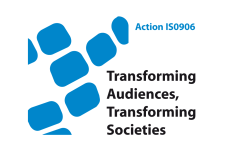- About the Action
- Events
- PhD workshop - Ljubljana 2014
- Action Open Conference - Ljubljana 2014
- New Media and Participation conference - Istanbul 2013
- Belgrade meeting 2013
- Media literacy research and policy - Brussels 2013
- ICA Pre-Conference 2013
- Tampere meeting 2013
- Budapest workshop 2012
- Milan meeting 2012
- Brussels PhD workshop 2012
- Brussels Action workshop 2012
- London meeting 2011
- Zagreb Conference 2011
- Lisbon meeting 2010
- Affiliated events
- WG 1
- WG 2
- WG 3
- WG 4
- Cross-WG
- Output
Changing media and methodological challenges of monopolistic audience measurement business
Ala-fossi, M. (2011). Changing media and methodological challenges of monopolistic audience measurement business. Zagreb conference: "New challenges and methodological innovations in European media audience research". 7-9 April 2011.
Abstract: Commercial ratings companies have been incapable to decide how to react on increasing supply and demand of typical broadcast media content on the internet. For example, the only broadcast audience measurement company in Finland, Finnpanel has recently accused a government agency, FICORA for spreading “misleading information about television viewing” after people interviewed in FICORA consumer survey estimated that they watch now little more audiovisual content from the internet and slightly less linear broadcast TV than on the previous year. Finnpanel argues that internet-based survey is a biased way to study TV audiences, although the company itself measures only audiences viewing live or recorded content via TV meter device and practically neglects all other viewing on other devices. On the other hand, the same company adds all internet radio station listening reported in their diaries into the total figures of radio listening. My main argument in this paper is that although the problem of measuring audiovisual audiences of non-broadcast platforms like internet and mobile is methodological, the main reasons behind the current inability or reluctance to update the methods are more economical. Conventional broadcast audience research methods are rather simple and cost-efficient, while any further development of more accurate and complicated methods would require both investments and willingness to accept lower productivity of research business in the future. However, large audience measurement companies often have monopolistic market position, so instead of having a motive to be sensitive to any changes in media environment, they rather seek to maintain the status quo.

